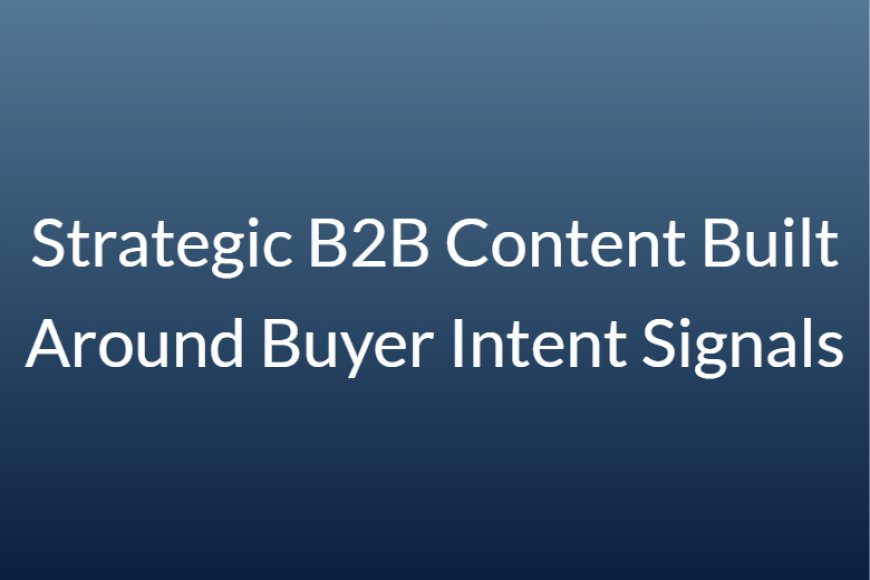Strategic B2B Content Built Around Buyer Intent Signals
In the B2B landscape of 2025, data is abundant but action based on intent is what sets high-performing strategies apart. A modern B2B Content Strategy is no longer centered around just pushing out content. It’s about creating personalized journeys that reflect what buyers are actively searching for, reading, and engaging with.

Buyer intent reveals where your prospects are in their journey and what questions theyre trying to answer. Using this insight to shape your content roadmap can result in stronger engagement, higher conversions, and more efficient use of resources.
Behavior-Led Content Creation: The New Standard
Content calendars used to be based on seasonal trends or product updates. But in an intent-firstB2B Content Strategy
, planning is driven by behavioral signals. Whether its a spike in searches around a specific solution, or increased downloads of a particular guide, these actions inform what your next piece of content should be.
By studying these patterns across your site and channels, marketers can move from reactive content to proactive messaging that reaches buyers before they even fill out a form.
Designing the Funnel Around Intent Themes
Each stage of the buyers journey should have distinct content aligned with known intent triggers. A forward-thinking B2B Content Strategy crafts a funnel that includes:
-
Top of Funnel: Educational blog posts, thought leadership articles
-
Middle of Funnel: Analyst reports, comparison charts, curated webinars
-
Bottom of Funnel: ROI calculators, implementation guides, product FAQs
The key is to ensure each piece of content is intentional and directly addresses the decision-making needs of the user.
Intent Data and Audience Segmentation
While firmographics are useful, segmentation powered by intent delivers more relevant outreach. A strong B2B Content Strategy uses data points like recent web activity, search behavior, and content consumption patterns to build micro-segments.
For example, companies researching ABM tools for mid-market can be placed into a segment that receives ABM-specific success stories, toolkits, and decision guidesrather than generic content.
Topic Clustering with Intent Anchors
The cluster model works even better when layered with intent. Your B2B Content Strategy should identify core topics based on high-intent keyword groups, then build out supporting articles around related subtopics.
Example:
-
Pillar: Leveraging Intent Data for Lead Generation
-
Clusters:
-
Top Intent Data Providers in 2025
-
B2B Content Formats That Support Buyer Intent
-
Intent Data vs. Demographic Targeting: What Works Better?
-
This content structure benefits SEO while also guiding buyers through increasingly relevant stages of their journey.
Choosing Formats That Match Buyer Intent
The type of content you offer should reflect not just funnel stage but also the urgency and intent of the prospect. In an optimized B2B Content Strategy, content formats evolve with the buyers level of interest.
-
Quick-read formats like checklists for early interest
-
In-depth reports and webinars for comparison shoppers
-
Interactive demos and ROI tools for late-stage evaluators
Giving prospects the right format at the right moment keeps them moving and reduces dropout at critical touchpoints.
Automating Engagement Based on Real-Time Triggers
Automation isnt about blasting emailsits about reacting with relevance. An intent-focused B2B Content Strategy uses marketing automation to serve contextual content after specific behaviors.
Examples include:
-
Viewing a pricing page ? send a Cost Justification Guide
-
Downloading a whitepaper ? trigger a follow-up drip campaign
-
Abandoning a sign-up form ? deliver a simplified one-click version via retargeting
These small shifts improve the buyer experience and ensure they receive helpful content when it matters most.
Aligning Marketing and Sales on Intent Insights
Sales and marketing alignment is stronger when both teams operate from a shared understanding of buyer intent. A successful B2B Content Strategy empowers sales teams with real-time access to what prospects are engaging with.
When reps know a lead has read a specific case study or interacted with a product comparison page, they can follow up with personalized outreach that resonates more deeply and accelerates the deal.
Using KPIs that Reflect Buyer Movement
Traditional metrics like bounce rate or open rate only tell part of the story. A high-performing B2B Content Strategy tracks KPIs that align with intent and funnel progression, such as:
-
Time spent on high-intent pages
-
Click-to-conversion rates on decision content
-
Repeat visits from key accounts
-
Engagement scores by content format
These performance indicators provide insights into whats actually moving buyers toward action and where your strategy needs refinement.
Read the Full Blog Now @ https://acceligize.com/featured-blogs/smart-b2b-content-strategy-aligned-with-buyer-intent/
About Us
Acceligize is a global B2B demand generation company empowering marketing and sales teams through intent-driven lead generation and automation-first solutions. Our programs are designed to align with todays buyer behaviors while simplifying complex sales funnels. With expertise in content syndication, programmatic engagement, and real-time insights, Acceligize helps you scale your lead pipeline efficiently and effectively.























